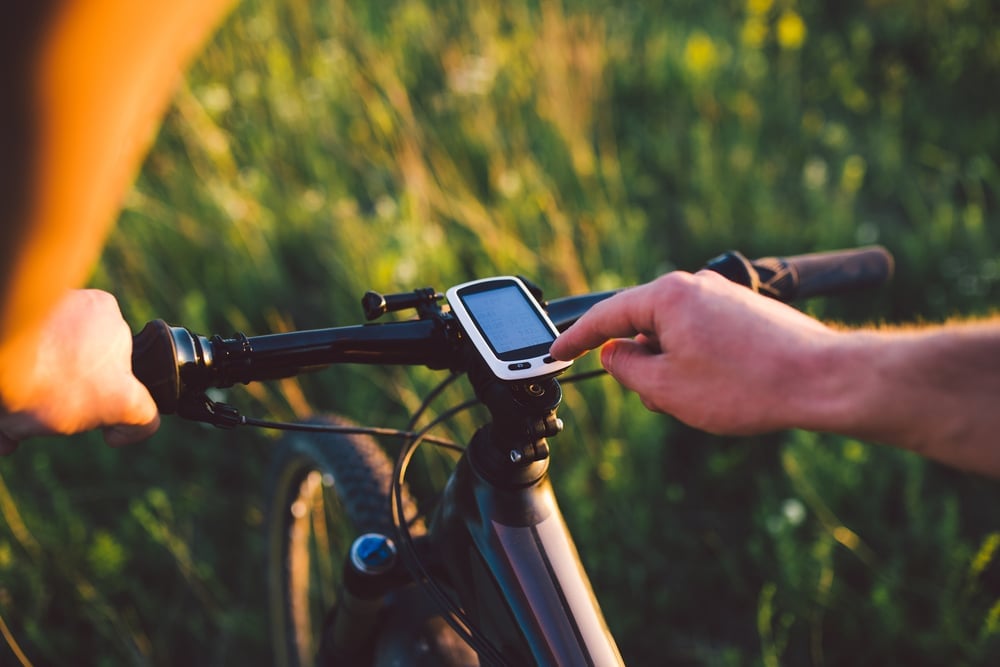When you first get into cycling, it’s easy to get caught up in the beautiful breeze, the shining sun, and just rolling along. Some of us are in it for speed, some for exercise, and some for leisure. No matter why you first got on the bike, as you become more serious and start to ride more often, you’ll probably want a bike computer to help you track your speed, distance, and elapsed time.
Bike computers are more advanced than ever and there are now computers with more data available than you could probably even utilize. Some computers even track the number of watts you push against the pedals. But in the budget bike computer space, we’re more concerned with the basics. That being said, there’s a huge variety of computers with different features and we’re here to help find you the best one.
Contents
Factors to Consider in a Cheap Bike Computers
Durability
As with anything, you want a bike computer that’s going to last. Especially when it comes to cheaper models, bike computers can be prone to breakage or simply just stop working—and that’s not what you want in the middle of a long ride. Make sure you buy something that will hold up to a punishing excursion.
Functions
Almost all bike computers will have the same basic functions like speed, distance, elapsed time, and a clock. After that, things start to vary quite a bit. There are a whole host of data options that different computers can show you. Some computers measure your cadence, which is how fast you turn the pedals, others have lap timing features, and some measure calories. It’s up to you to decide what your priorities are, and more data doesn’t necessarily mean it’s a better bike computer, especially if it’s data you don’t use.
GPS Capability
Although most GPS-equipped units are premium models and usually cost more than $100, in recent years some stunningly inexpensive GPS devices have come onto the market. GPS functionality isn’t only for turn-by-turn directions anymore. You can also upload your ride to your computer and analyze your speed, cadence, and all available data for any given point in your ride. GPS is a great feature for those who want to plan their route out.
Wireless vs. Wired
In the last few years, we’ve seen the bike computer industry shift away from wired computers, which use physical cables to send information to the main display. In many cases, they’ve been replaced by wireless models that use Bluetooth or ANT+ technology to transmit data. Wireless models, especially on cheaper computers, tend to be less reliable, but wired models are more difficult and time-consuming to set up. Wired bike computers are also usually cheaper.
Desktop Compatibility
If you’re a data-obsessed cyclist, you will want a bike computer that can connect to your desktop or laptop at home for analysis and storage of rides. This way, you can track not just your day-to-day outings, but you can also upload your data to software that can analyze trends in your cycling. This data can provide insights about your fitness, average speed, average ride distance, and more.
Best Cheap Bike Computers Under $50
1. Cateye Velo 9
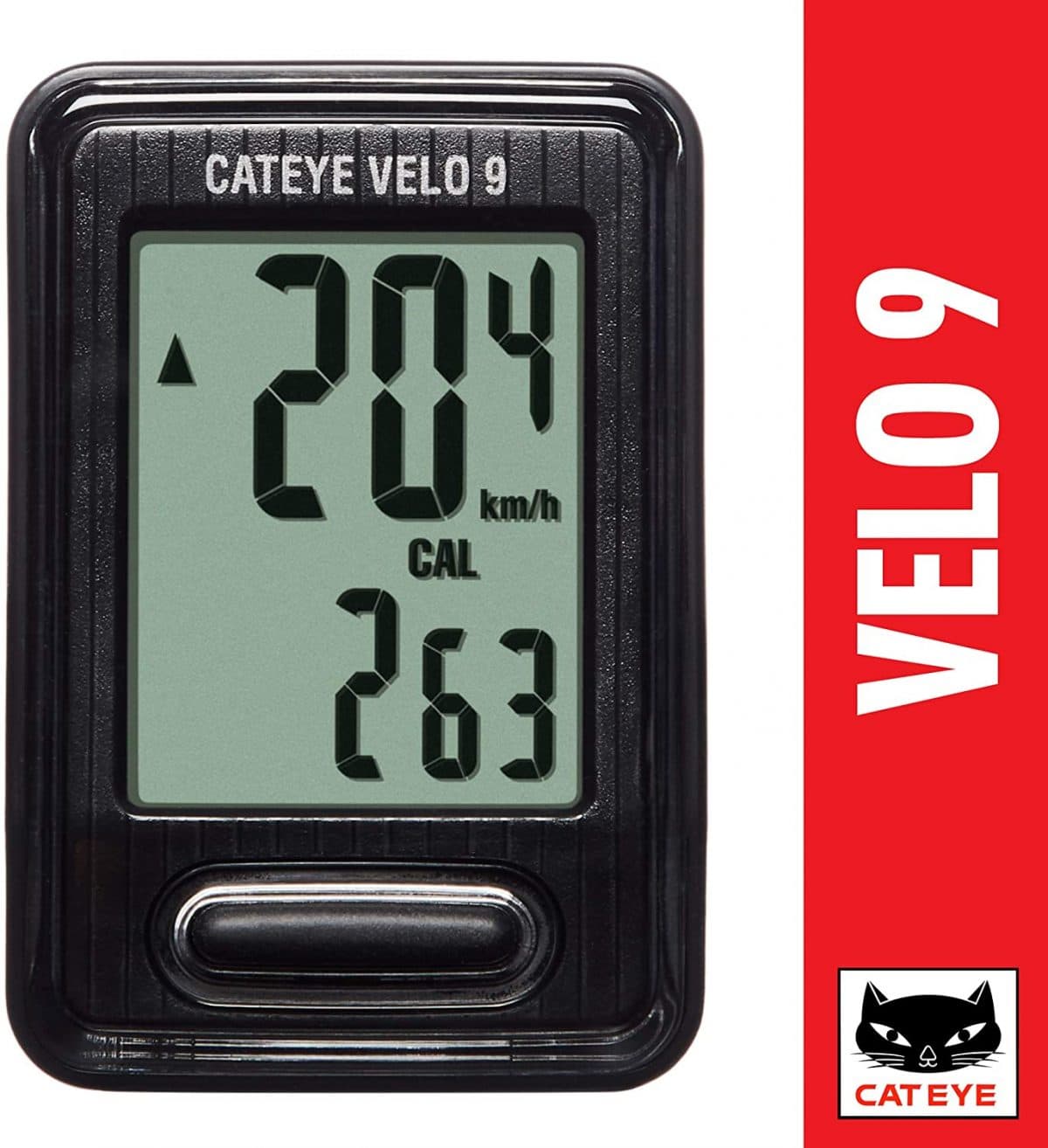
Editor’s Rating:
By emphasizing simplicity and ease of use, Cateye has made a product here that is better than a whole host of more expensive models. With its simple design, this model has a reputation for being unbreakable, and it’s waterproof on top of that. As far as keeping track of the basic metrics, it’s got all of them covered.
It also comes with a battery and zip ties, so it includes everything you need to get on the road, no hassles. It’s wired, so there’s a hardline connection that runs right down to the sensor by the wheel. This wired connection is reliable, but it’s a bit more time consuming to set up.
Cateye is one of the biggest bike computer manufacturers out there, and this model shows how it got there. The Velo 9 isn’t the cheapest on the market, but for such a solid product from such a reputable manufacturer, it’s well worth the money you pay. If you’re looking for a similar but even cheaper option you can check out the Cateye Velo 7 , which has fewer features but will save you a few dollars.
One super convenient feature on this computer is its auto-stopping function. When you stop at a red light, coffee shop, or your final destination, the computer shuts off the time automatically. This is great for making sure your average speed and ride time is accurate. The computer is also simple to use while riding. The interface to cycle through the available data is intuitive and easy to learn. Well-thought-out features like these are what makes this computer stand out as one of our favorites.
Functions: The Cateye Velo 9 has, as you might guess, nine functions. It displays current, max, and average speed. Its secondary functions are total distance, trip distance, elapsed time, time of day, and calories. A couple more unique features that it has are the pace arrow, which tells you if you’re going faster or slower than your average speed, and a carbon offset counter, which tells you how many kilograms of carbon you’ve saved by using your bike instead of your car.
- Auto-stop feature
- Simple, solid construction
- Easy to use
- Thoughtful design
- Waterproof
- Wired connection
- Only 9 functions
2. Sigma BC5.16 Wired Cycle Computer
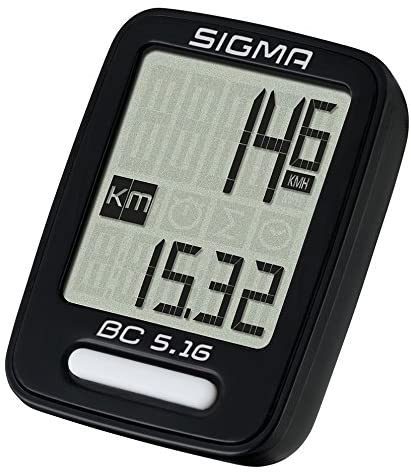
Editor’s Rating:
This is an excellent no-frills bike computer at a rock bottom price. It’s a wired computer that has a focus on telling you the big five a casual cyclist might want to know, and unfortunately, very little else. It’s water-resistant (IPX7), so it can be taken out on a harsh day of weather and is an unobtrusive matte black color and is very compact. It also detaches easily from the bike when you arrive at your coffee shop and is small enough to fit into your pocket without hassle. Altogether this is a great pick for the starting or hobby cyclist who isn’t taking the numbers too seriously yet.
Functions: This simple computer will tell you your actual speed, total distance, ride time, the actual time, and a lifetime odometer. The numbers are displayed bright and clear and are accessible at a quick glance or press of a button. It will also auto-stop when you do to save it calculating wasted time. Sadly, there is very little else to offer on this machine. Yet if you just want the basics, this’ll do fine.
- Five key data points
- Easy to use
- Easy to see the numbers
- Small, unobtrusive and pocket-sized
- Waterproof
- Other than the basics listed, there are no additional features whatsoever.
3. Meilan M3 Mini Bike Computer
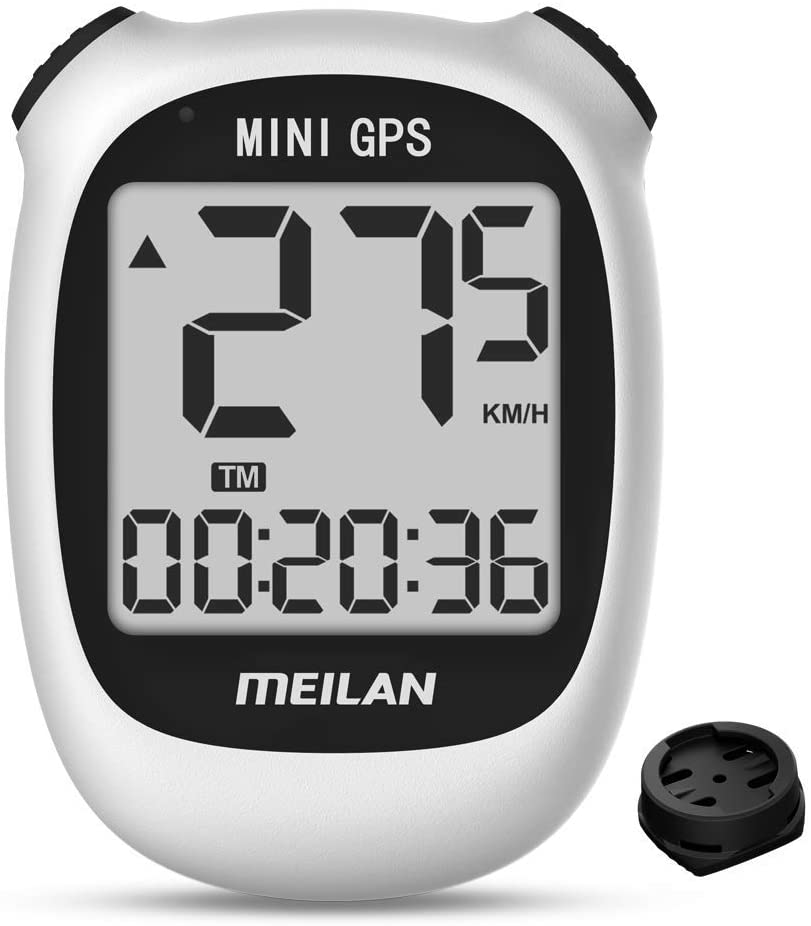
Editor’s Rating:
When we found out there was a GPS-capable computer on the market for under $50, we were blown away. It’s hard enough to find a high-quality GPS device under $100, and this is in another stratosphere of affordability. Unfortunately, there’s a catch. You can’t use this computer for navigation. So what’s the GPS for, then? The navigational system is for tracking data only. So while you can’t get turn-by-turn directions, you can upload the ride to your online ride tracking apps like Strava and TrainingPeaks once you get home. The GPS also tracks speed, which means there’s no magnet to install on your wheel.
As far as setup goes, a mount attaches to your handlebars, and once you click the computer into place, you’re ready to roll. The mount works in four directions, so you can set up the anti-glare, backlit screen on your handlebars or the stem (the piece that connects your handlebars to the bike). It uses zip ties to attach, so unfortunately, you can’t transfer it to another bike.
The one thing that keeps this computer from taking the top spot is its slow GPS pairing. Before each ride, you have to keep the bike completely still as you wait for it to connect to its GPS functionality. This can take up to a couple of minutes. Along with slow pairing, it experiences occasional GPS dropouts, and it’s possible you’ll end up pedaling along with the sensor not reading your movement. It’s usually not too much of an issue, and the GPS reconnects after a few seconds. Still, if you want hyper-accurate data readings, you should look for a more reliable offering like the iGPSPORT iGS50E.
First time setup of the computer itself is difficult, and you have to navigate a confusing maze of settings to change the computer from KPH to MPH. Once you get familiar and you have things set up the way you like, the interface is much more user friendly. Battery life is about on par with other GPS devices but short for the sub-$50 category, and the computer has to be charged after 8 hours of use.
Functions: The star of the show here is the GPS, which is utilized to measure current, average, and maximum speed as well as all distance fields including altitude. It’s also got current time and elapsed time, plus a nifty feature that shows your pace as compared to the average pace for that particular ride. The computer comes with a Micro-USB port to import data and to charge the device.
- Affordable GPS technology
- Anti-glare screen
- Wireless
- Bright backlight
- No magnet to install
- Confusing setup
- GPS issues
4. Planet Bike Protege 9.0
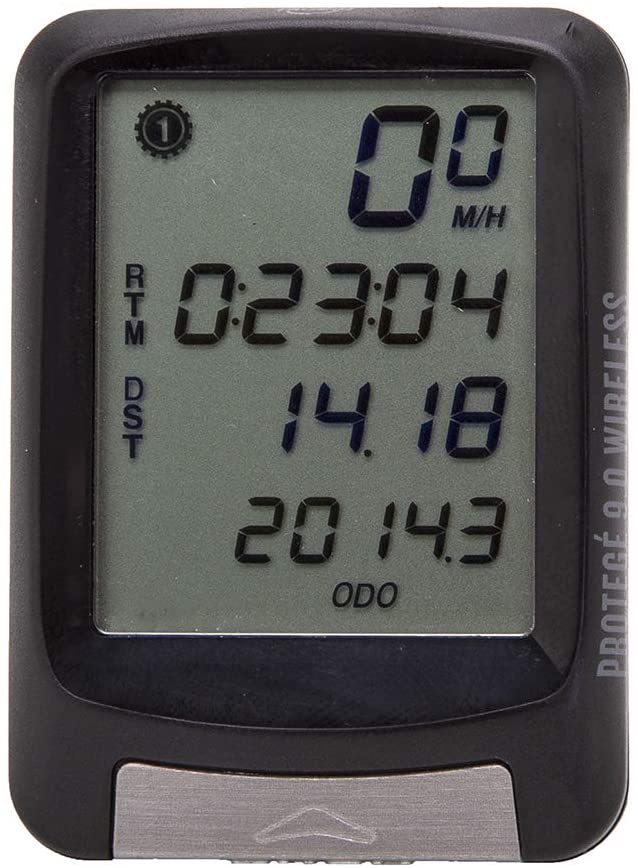
Editor’s Rating:
This bike computer offers excellent durability and battery life in a slick, square package. We like its minimal design, and the computer is small, but it’s large enough to clearly read the data fields. We also appreciate the fact that Planet Bike is a US-based company that backs its products with a lifetime warranty. Other companies in the space just don’t offer the same guarantees with their products.
Planet Bike did something a little different here, and we love the concept. Instead of just displaying a few data fields with the option to scroll through one by one, the device only has two menus. With the touch of a fingertip, it cycles back and forth between both screens, each of which displays five data fields. Resetting the computer is accomplished by a longer press on the screen. We love the simplicity, as there’s no button, and we recommend this for cyclists who don’t want to spend time fiddling with the computer while rolling along.
Setup is not too difficult but the device does require installation of a wire-connected sensor near the wheel. Planet Bike has had some difficulties with the computer mount breaking, and extra attention should be paid during the install so that you don’t look down during a ride and find your bike computer missing.
Functions: The Planet Bike Protege displays current, average, and maximum speed as well as a ‘speed comparator’ that tells you if you’re cruising faster or slower than normal. There’s no lifetime odometer, which we found strange, but a little mental math will do the job. Its clock is set up on a 12-hour cycle, and it has a feature that is unique to computers at this price point: a thermometer, which is great for earning bragging rights in extreme weather.
- Simple screen
- Easy data field navigation
- Lifetime warranty
- Good battery life
- Unreliable mount
- Tricky wired installation
5. Cateye Velo 7
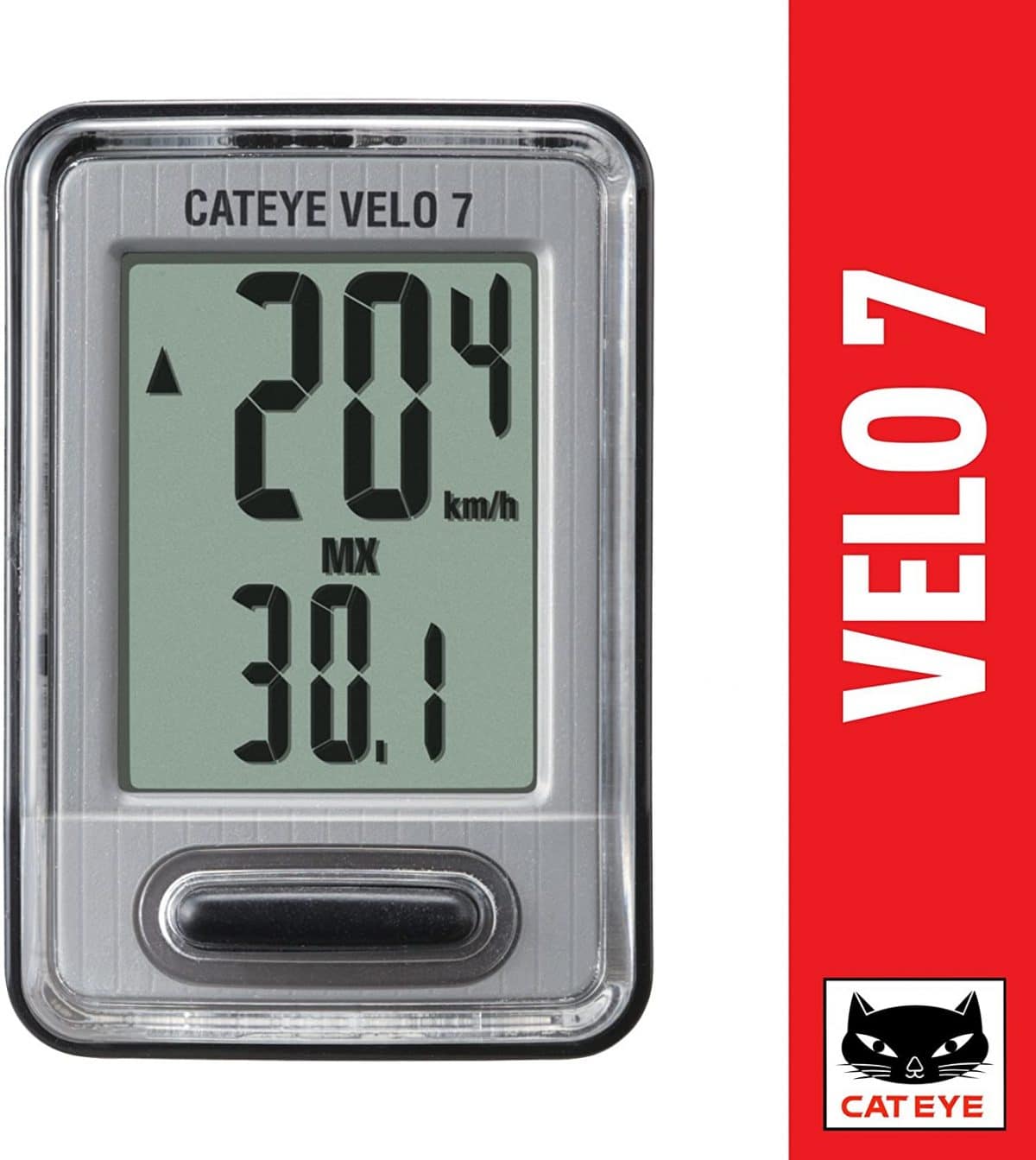
Editor’s Rating:
The Cateye Velo 7 saves a few bucks but sacrifices a couple features over its big brother, the Cateye Velo 9. The strong points of the Velo 9 carry over to this bombproof computer. It’s durable, simple to use, compact, and reliable. The features are minimal, but for riders that just need the basics, it is perfectly adequate.
The computer is small but the screen is big enough to read, about the size of a matchbook. The small size doesn’t make it difficult to use, as its single button is easy to manipulate even with cold or sweaty hands. The screen is small, but more than big enough to display the main data field (speed) in a large font. The smaller, secondary data field can be tricky to see. This computer is only available in light grey, and we would like to see other color options available.
At the end of the day, though, the $5 difference doesn’t feel like it’s enough to justify the missing features on this computer. However, if you don’t care about the measuring calories and you like the color, save your money and buy this version.
Functions: Named for its seven functions, this is one of the simplest computers in the lineup. It’s got maximum, average, and current speed, as well as trip distance, total distance, elapsed time, and a clock. If you’re curious, the features that differentiate this computer from the Cateye Velo 9 are the ‘Calories’ and ‘CO2 Emissions Saved’ data fields.
- Simple to use
- Single button
- Easy to read screen
- Bombproof
- Inexpensive
- Only the simplest functions
- Small secondary data field
6. Dinoka Bike Speedometer
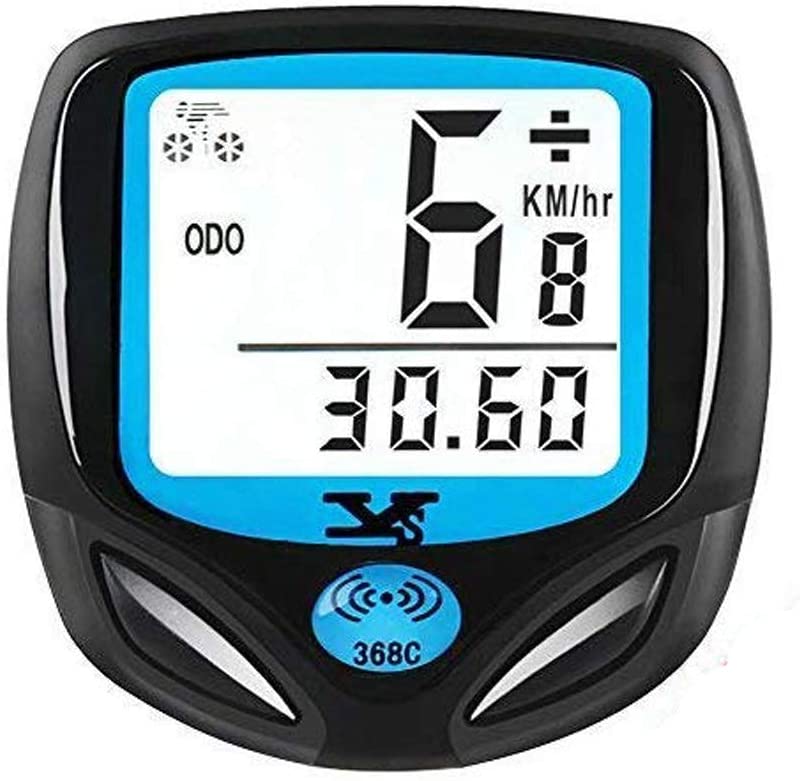
Editor’s Rating:
Without a doubt, what blows us away on this computer is its wireless functionality delivered at an incredibly low price. It’s got all the standard features that most riders will need. Setup is easy but a little finicky when placing the magnet and sensor on the wheel. We don’t like the looks so much, with its rounded bottom and blue accents, but at this price, we can’t complain.
Riders who use this device sometimes complain that parts of the easy-to-read LCD screen can stop working at random, but it doesn’t make the computer unusable. That being said, for a wireless computer, it’s got a ridiculously low price, and you could buy three of these for the price of many other similarly-featured bike computers.
The construction doesn’t feel as solid as the other options on the list, especially more expensive computers. We’re a little bit concerned about long term durability for this model given its cheap-feeling plastic and buttons.
Functions: As far as functions go, the Dinoka computer is pretty basic. It’s got speed, average speed, maximum speed, trip distance, and an odometer, as well as a clock and elapsed time. It lacks calories burned, which computers like the Cateye Velo 9 have.
The last cool feature this computer has is an auto-scrolling function, which automatically scrolls through the different data fields as you ride. If you’re a little timid about taking your hands off the bars while your ride, a computer with an auto-scroll function is a good option.
- Excellent price
- Wireless
- Screen is easy to read
- Auto-scroll function
- Finicky setup
- LCD issues
- Long-term durability
Best Cheap Bike Computers Under $100
1. Cateye Strada
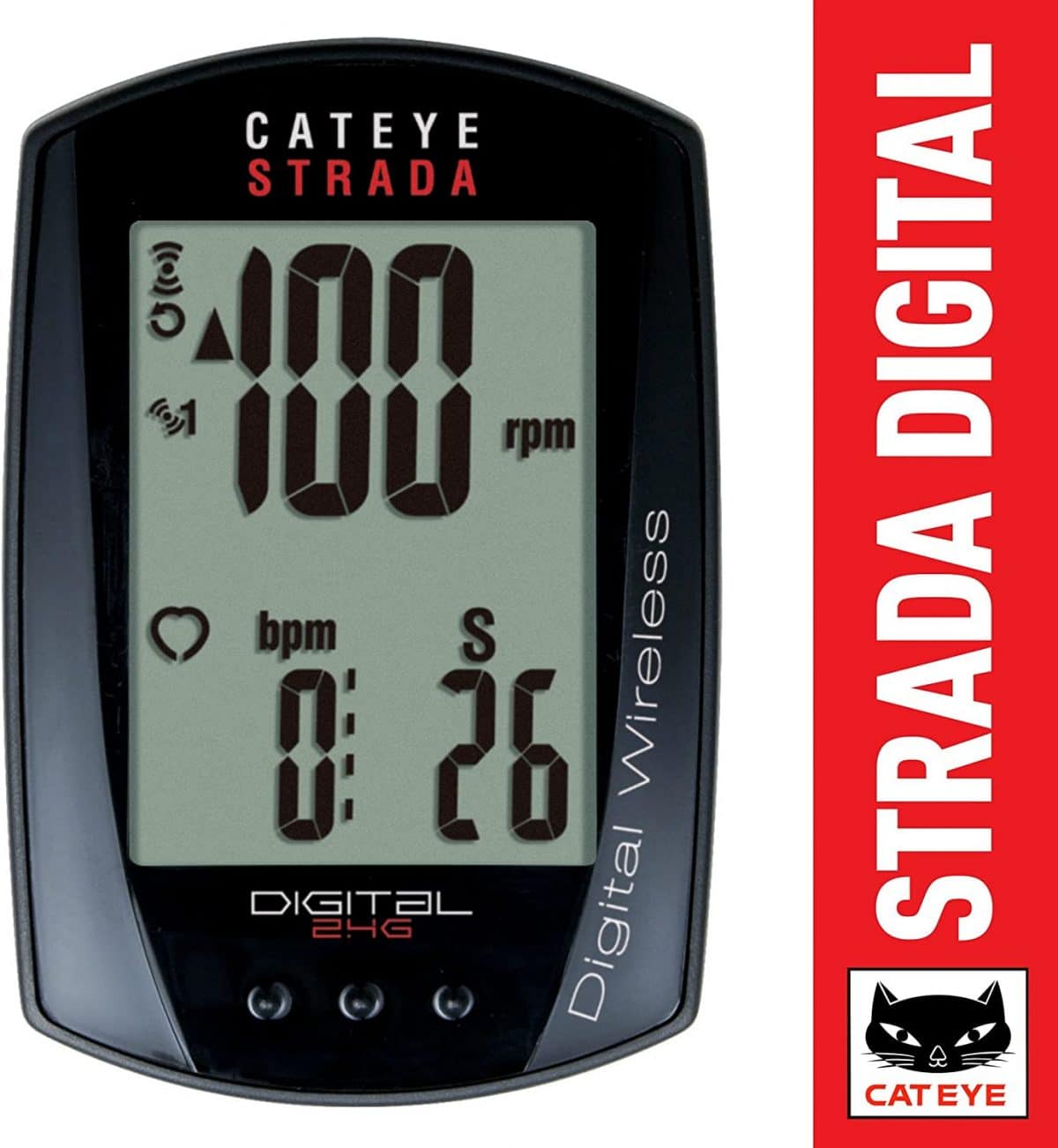
Editor’s Rating:
Cateye continues its run into our $100+ category by embracing the same features that it always does: attention to detail, ease of use, and durability. While some manufacturers have struggled with signal reliability on their wireless computers, Cateye’s execution here is completely flawless, and you’ll have no trouble with dropouts. Even though it has a durable, drop-resistant construction, the computer only weighs 20 grams, so it won’t slow you down when you’re riding up a hill.
Installation is easy here with no wires to worry about. You just attach the sensors and computer with zip ties and the data begins to transmit automatically. After it’s installed, it’s easy to read and navigate the menus, even while riding. The hardest part about installation is placing the magnet on the pedal properly, you have to get it just right to read correctly.
Yet another bonus for this computer is that it comes with the capability to be set up with a heart rate monitor to track your pulse. That piece of equipment would push you well into $100+ territory, but if you’re thinking about getting more serious with your training, it’s a nice feature to have in case you want to upgrade.
Functions: The higher you get in price, the more functions become available, and the Cateye Strada is no exception. It monitors current, average, and maximum speed. It’s also got total distance, trip distance (you can run two trips simultaneously), and elapsed time.
The Strada also manages to pack in a new feature on this computer, cadence. By placing a sensor near your pedals and placing a magnet on the pedal itself, you can track the revolutions per minute at which you pedal. Cadence is associated with pedaling efficiency, and riders should try to maintain between 80-100 pedal strokes per minute.
- Cadence tracking
- Seamless wireless functionality
- Easy installation
- Durable construction
- Heart rate monitor compatible
- More expensive
- Difficult-to-install cadence magnet
2. iGPSPORT iGS50E
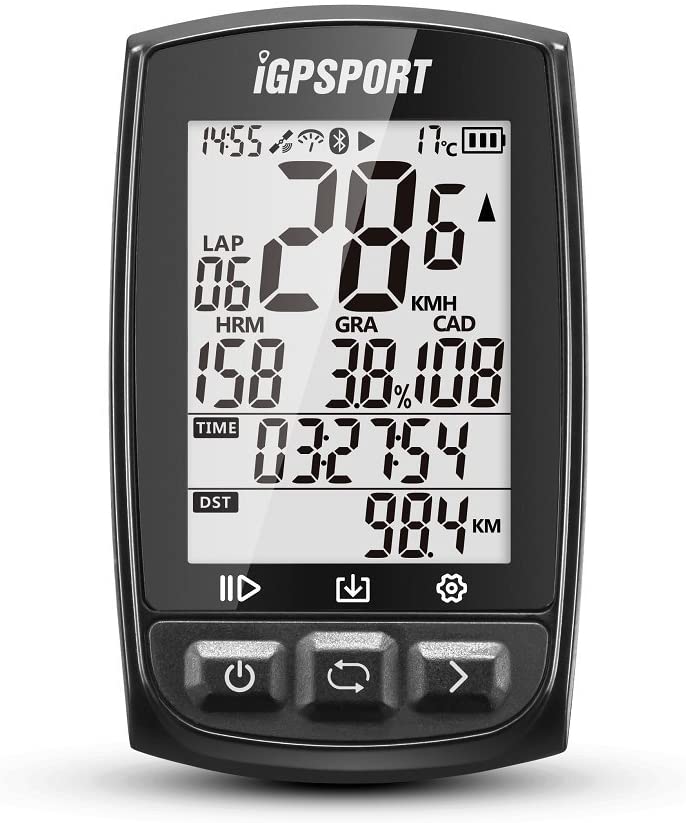
Editor’s Rating:
We’ve long been waiting for a high-quality turn-by-turn navigation enabled unit to dip under the $100 price point, and with this device, we finally find a worthy candidate. The iGPSPORT computer is relatively substantial, with a large 2.2-inch anti-glare screen that is navigated using three buttons at the bottom.
Navigation is simple and the menus are easy to fill up with the many functions available on this model. The GPS is reliable and rides can be uploaded online via a native, easy to use phone app. The app can be somewhat fussy, though, so have patience. If all else fails you can always upload routes with a desktop or laptop, directly connecting the bike computer using the included Micro USB cable.
You can’t have everything though, and while this unit does have GPS capability it lacks a cadence sensor like many of the other picks on this list. It makes up for that somewhat by having ANT+ capability, so you can upgrade to a heart rate monitor or a cadence sensor later, and it will easily pair with this computer.
Battery life is great for a GPS equipped device, and there’s a 1-year warranty that backs the computer in case of any breakage. However, the company has had some quality control issues in the past, and the cheap-feeling body and screen make us think it won’t last as long as its counterparts. If you need something that will be reliable for years to come, go with a standby such as the Cateye Strada
Functions: Included are the average, maximum, and current speed functions, as well as riding time, trip distance, total distance, altitude, and temperature, as well as time and calorie counts. Unlike other computers this device tracks the gradient of the hill you’re riding on, displaying the percentage grade. The ANT+ capability requires additional purchase of sensors, but cadence and heart rate can also be added if you should choose to upgrade.
- GPS compatible
- ANT+ equipped
- Large anti-glare screen
- Great battery life
- No cadence sensor
- Less-than-stellar build quality
- Fussy phone app
3. Cateye Padrone
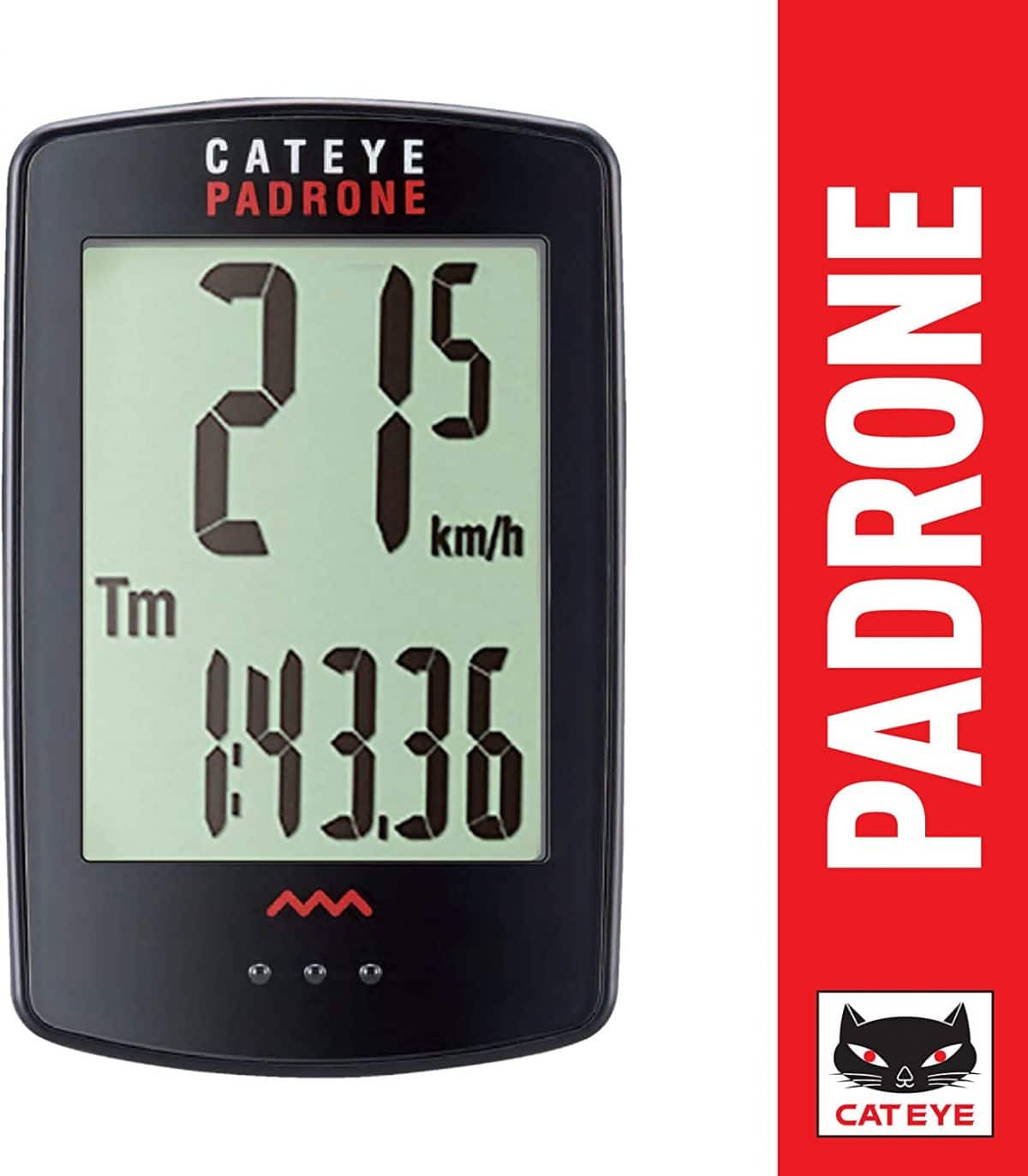
Editor’s Rating:
Cateye’s flagship wireless model is one of our favorites, but it is a bit more expensive than other similarly-featured models. It’s worth it for its large screen size and the reliability it offers: customers say that their Cateyes can last for years without fail. Heck, Cateye claims that even the battery will last over 6000 miles of pedaling. It’s hard to wear these things out.
The Cateye Padrone isn’t just a wireless version of the equivalent wired model , it’s a completely redesigned and updated computer. The display is both lighter and thinner, and the way it attaches to the handlebars is updated as well as reusable (past versions use zip ties, this version uses rubber bands). Installation is incredibly easy thanks to the wireless design. While some wireless computers have trouble with signal dropouts, the Cateye Padrone is flawless when set up properly. The only thing to watch out for is nighttime use, as the use of bike lights can interfere with signal transmission.
The computer is made out of solid injection-molded plastic, and the screen is large and shatterproof. It’s only got one button, which makes it incredibly easy to navigate, although with many functions it can take a bit of time to scroll through all the data fields to get to what you want. Unlike other speedometers, it comes in a variety of colors, which allows you to match the computer to your bike.
Functions: The Padrone is fully-featured but doesn’t have many extra bells and whistles. As well as the standard current, average, and maximum speed, it measures trip and total distance. Clock-based functions featured are elapsed time, stopwatch, and time of day. It also has an auto-start and auto-stop feature, so you can set it and forget it.
- Incredibly reliable
- Slim design
- Large screen
- Wireless
- Signal dropouts when using bike lights
- Not a lot of extra functions
4. Meilan M4 Wireless Cycling Computer
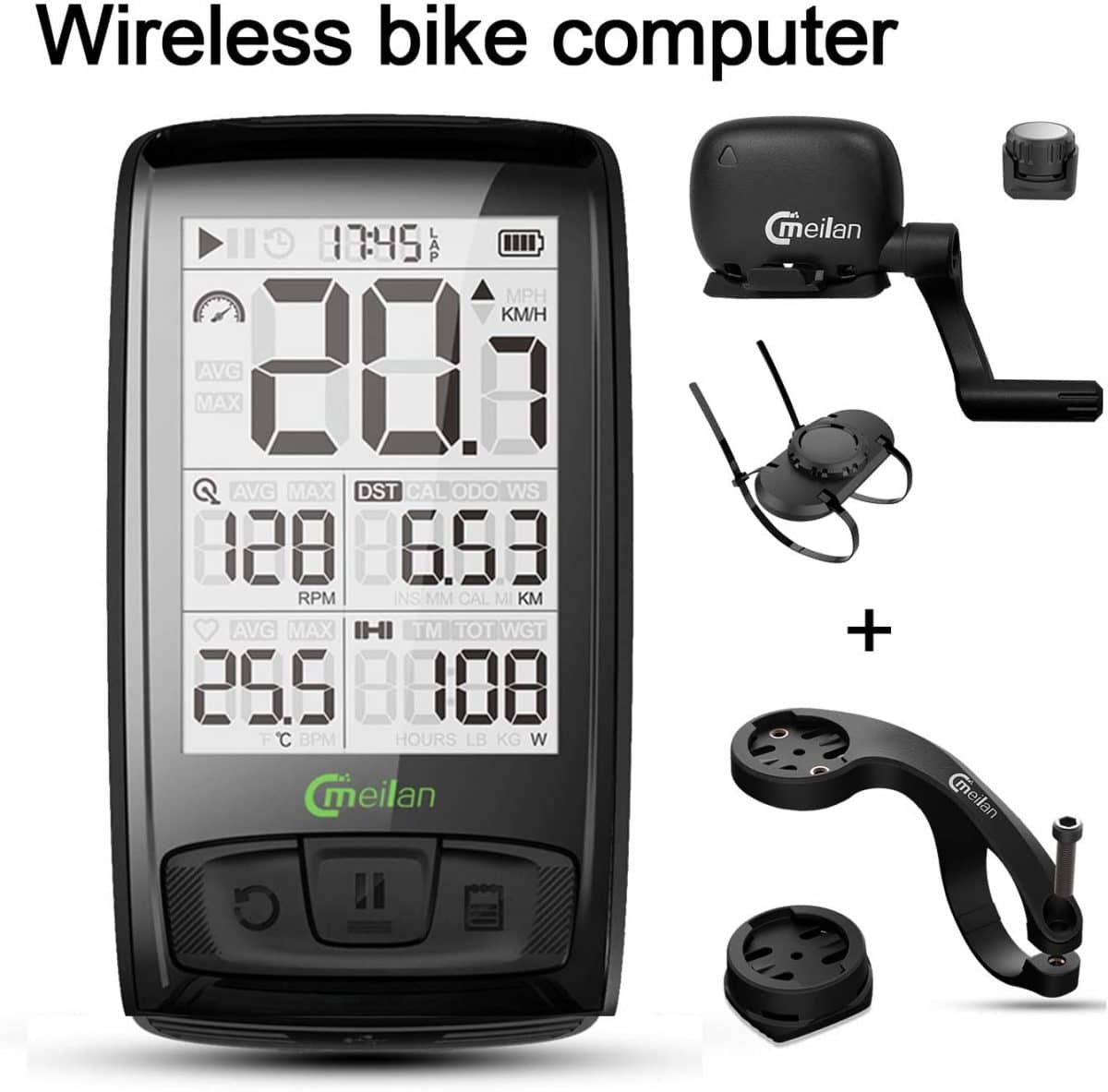
Editor’s Rating:
The Melian M4 has the biggest display in our lineup, with a whole 2.5 inches of backlit LCD screen. It has 5 data fields, with the main speed field up top and four smaller fields below. The device is a little bulky, but it can be installed to tuck away nicely in front of the handlebars with the included ‘out front’ mount. Setting up the data fields is easy, but a confusing manual means that if you get stuck, it’s your problem. The cadence and speed sensor come in one unit, which is situated by the pedals. It helps make for an easy install.
The waterproof computer is charged via an included micro-USB port, although with 40 hours of claimed ride time you won’t have to plug it in much. It’s both Bluetooth and ANT+ compatible, both of which can connect to a phone app for uploading and tracking data. The ANT+ can also be used by those who want to hook up a heart rate monitor, but that comes separately.
The biggest complaints are all related to the life cycle of the product. In most cases, lifetime is just as good as the premium Cateyes on the market, but it’s possible to experience malfunctions after just a couple of months. Either way, there’s a solid return policy in place to address any concerns.
Functions: The Meilan M4 comes with a whole suite of features, starting with current, average and max speed, and including a clock, elapsed timer, lap timer, distance field, lap distance, average cadence, current cadence, calories, battery level, and temperature. Additional functionality can be added with the purchase of a Bluetooth capable or ANT+ compatible heart rate monitor.
- Large screen
- Great battery life
- Waterproof
- Included ‘out front’ mount
- Confusing manual
- Long term usability concerns
5. Cateye Strada Slim
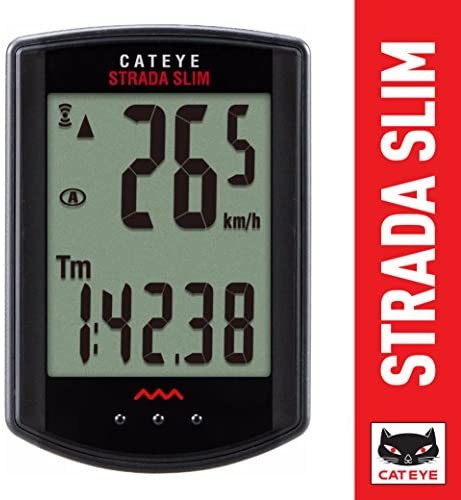
Editor’s Rating:
Cateye recognized a niche with the Strada Slim, catering to those who wanted a higher-end offering without cadence and making a few enhancements along the way. The computer is ridiculously light, weighing in at just about 12 grams, the same as an empty aluminum can. They also enlarged the screen, making it easier for riders to read the data as they roll along.
Aside from the physical differences, the computer remains pretty much the same on the inside. The same LCD technology powers the display, the same wireless sensor tracks speed. Functions are similar, although there’s no way to set up the computer for cadence even if you want to buy a sensor further down the line. The simplicity makes it very easy to use and operate.
Battery life is phenomenal, and the screen will last over a year with an hour of usage per day. Another feature it borrows from the original Cateye Strada allows you to set profiles for two different bikes and toggle between them to track mileage and ride time independently.
Functions: The Strada Slim has plenty of features but unfortunately has no cadence or heart rate functionality. It displays current, average, and maximum speed as well as holding two trip distances, total distance, elapsed time, and a clock. It also has a pace arrow that displays if you’re going faster or slower than average. Clocking in at the same price as some GPS-capable units, we wish there were at least some extra functions to make up for its lack of Bluetooth and GPS technology.
- Super lightweight
- Big screen
- Simple to use
- Great battery life
- No cadence
- Pricey for no GPS or cadence sensor

